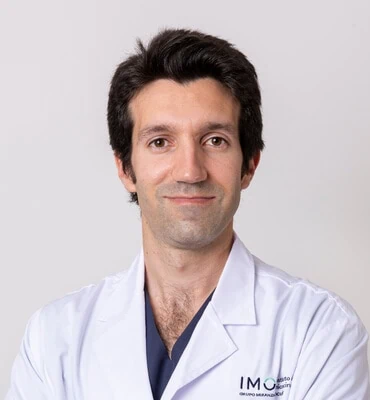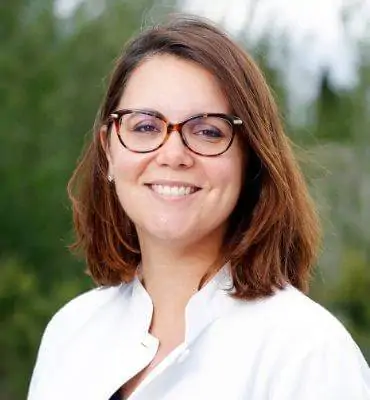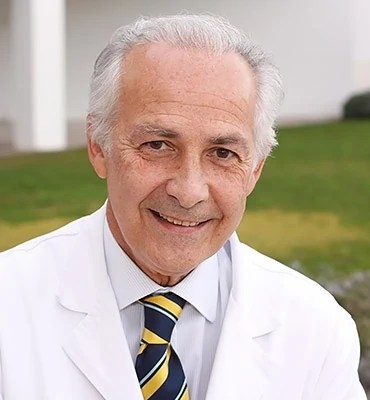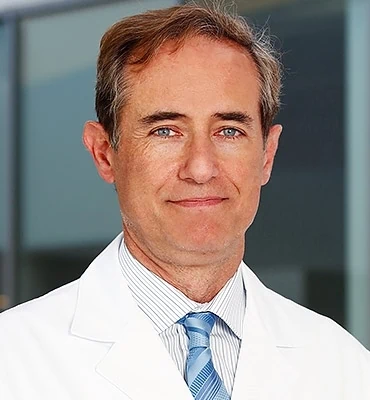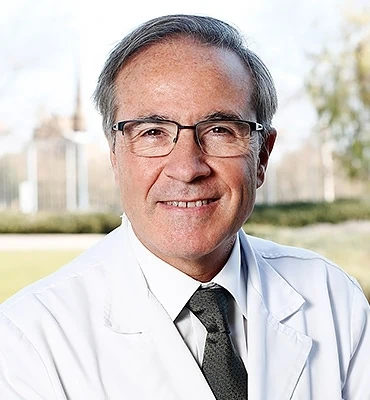What does it involve?
Photodynamic therapy is a treatment that involves the intravenous injection of a photosensitive drug, which is subsequently activated in the retina by applying a special light to the affected area.
En quins casos es fa?
Actualment ha passat a un segon pla respecte de les injeccions d’antiangiogènics per al tractament de la DMAE humida. Es fa servir en alguns subtipus específics de DMAE humida i, a vegades, en combinació amb antiangiogènics per tractar formes resistents de DMAE neovascular.
“És molt important el tractament a la fase inicial, quan la membrana posterior a la màcula es molt més sensible al fàrmac”. Dr. García Arumí – IMO Barcelona
When is it carried out?
Currently, this therapy is not used as extensively as anti-angiogenic injections for the treatment of wet AMD. It is used in some specific subtypes of wet AMD and, occasionally, in combination with anti-angiogenic drugs to treat resistant forms of neovascular AMD.
Prior examination
The same as for anti-angiogenic injection, but also essential is a fluorescein angiogram.
Before the surgery
Since a photosensitive substance is injected into the patient’s vein, after treatment the patient should avoid exposure to direct sunlight for two days to avoid the risk of burns.
Surgery
PDT is similar to laser treatment, but differs in that the process does not cause discomfort to the patient.
Risks
PDT is a non-invasive technique, and, as such, the risks are minimal.
Associated pathologies
Experts performing this treatment
FAQs
Eye tumours can occur on any tissue, but the most common in adults is choroidal melanoma, a malignant tumour that can be treated with radiotherapy and other treatments with notable success. Malignant tumours can also appear on the conjunctiva, the lacrimal gland and the orbit. Benign tumours can also appear, but they can be easily dried out. In children a retinal tumour known as retinoblastoma can appear, which looks like a white pupil and must be treated as soon as possible, as it can be life-threatening if appropriate treatment is not performed.
Yes, it is an emergency, but relatively speaking, as it is possible to wait 3 or 4 days. It is necessary to examine the eye, because the symptom could indicate the onset of decompensation, which can cause severe loss of vision. This distortion is sometimes not due to decompensation, but it always needs to be confirmed.
IMO Institute of Ocular Microsurgery
Josep María Lladó, 3
08035 Barcelona
Phone: (+34) 934 000 700
E-mail: international@imo.es
See map on Google Maps
By car
GPS navigator coordinates:
41º 24’ 38” N – 02º 07’ 29” E
Exit 7 of the Ronda de Dalt (mountain side). The clinic has a car park with more than 200 parking spaces.
By bus
Autobus H2: Rotonda de Bellesguard, parada 1540
Autobus 196: Josep Maria Lladó-Bellesguard, parada 3191
Autobuses H2, 123, 196: Ronda de Dalt – Bellesguard, parada 0071
How to arrive at IMO from:
IMO Madrid
C/ Valle de Pinares Llanos, 3
28035 Madrid
Phone: (+34) 910 783 783
See map in Google Maps
Public transport
Metro Lacoma (líne 7)
Autobuses:
- Lines 49 & 64, stop “Senda del Infante”
- Line N21, stop “Metro Lacoma”
Timetables
Patient care:
Monday to Friday, 8 a.m. to 9 p.m.
IMO Andorra
Av. de les Nacions Unides, 17
AD700 Escaldes-Engordany, Andorra
Phone: (+376) 688 55 44
See map in Google Maps
IMO Manresa
C/ Carrasco i Formiguera, 33 (Baixos)
08242 – Manresa
Tel: (+34) 938 749 160
See map in Google Maps
Public transport
FGC. Line R5 & R50 direction Manresa. Station/Stop: Baixador de Manresa
Timetables
Monday to Friday, 09:00 A.M – 07:00 PM




